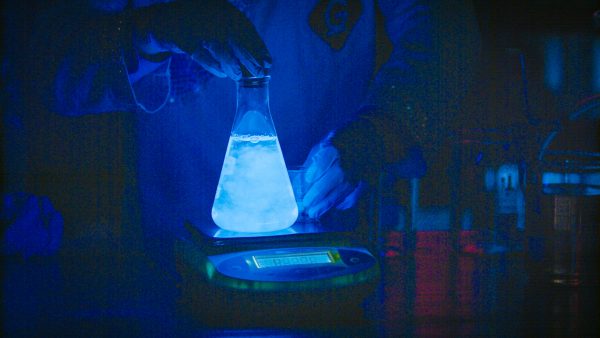Reactants Definition
Reactants combine or rearrange in a chemical reaction to form products. For example, hydrogen and oxygen react to create water.
View Lesson on Chemical Reactions
Become a member to get full access to our entire library of learning videos, reading material, quiz games, simple DIY activities & more.
Become a member to get full access to our entire library of learning videos, quiz games, & more.
Plans & Pricingto watch this full video.

Access All Videos
and Lessons, No Limits.
Access All Videos

No credit card required,
takes 7 sec to signup.
No card required

Ready-to-go lessons
that save you time.
Ready-to-go lessons
If you are on a school computer or network, ask your tech person to whitelist these URLs:
*.wistia.com, fast.wistia.com, fast.wistia.net, embedwistia-a.akamaihd.net
Sometimes a simple refresh solves this issue. If you need further help, contact us.
Chemical Reactions
Fun Facts
- Reactants usually have different properties than products, even though the same number of atoms are present before and after a chemical reaction.
- When a bath bomb goes through a chemical change, baking soda, citric acid, and water are the reactants.
- The carbon dioxide gas that is formed when a bath bomb undergoes a chemical change is not one of the reactants.
Why Do We Need To Know About Reactants
Learning about reactants helps us understand how chemical reactions create new materials and medicines. These reactions are important for our health and everyday life.
Reactants are used outside of science labs. Chemical engineers and scientists use them to figure out tough problems, like making better rocket fuel for space trips or flexible solar panels for wearable gadgets. This tells us that knowing about reactants can lead to many job opportunities and has practical uses too.
Frequently Asked Questions
Check out the Full Lesson on Chemical Reactions
In this lesson, we learn that:
- When substances undergo chemical reactions their properties change.
- The total number of atoms does not change throughout a chemical reaction.
- Scientists use chemical reactions to create new materials and medicines.
Related Topics
- Absorbency Definition
- Adaptation Definition
- Amplitude Definition
- Bioindicator Definition
- Camouflage Definition
- Chemical Reaction Definition
- Chemistry Definition
- Chloroplasts Definition
- Compound Definition
- Conduction Definition
- Corona Definition
- DNA Definition
- Distillation Definition
- Earth’s Rotation Definition
- Earthquake Definition
- Ecosphere Definition
- Electromagnetic Spectrum Definition
- Electron Definition
- Friction Definition
- Gas Definition
- Genetic Factors Definition
- Germination Definition
- Greenhouse Effect Definition
- Group Behavior Definition
- Invasive Species Definition
- Liquid Nitrogen Definition
- Lunar Eclipse Definition
- Lunar Mare Definition
- Magnetic Field Definition
- Mineral Definition
- Muscular System Definition
- Natural Disaster Definition
- Natural Selection Definition
- Nonrenewable Resource Definition
- Ocean Current Definition
- Organelle Definition
- Prey Definition
- Reactants Definition
- Soil Definition
- Soil Erosion Definition
- Sound Definition
- Thermal Energy Definition
- Thermometer Definition
- Tissue Definition
- Trait Definition
- Translucent Definition
- Vibrating Definition
- Wedge Definition
Start a Free Trial Today. Get a $5 Amazon Gift Card!
Teachers! Start a free trial & we'll send your gift card within 1 day. Only cards left. Try it now.
Select Grade
Select Subject
This email is associated with a Science Kit subscription. Kit subscriptions are managed on this separate page: Manage Subscription

-
Download InvoiceScience & Math$/yr
-
Download InvoiceScience Only$/yr

access all lessons
• No credit card required •
"My students loved the videos. I started the video subscription in May and used them as a review before the state test, which I know contributed to 100% of my class passing the state test."
Rhonda Fox 4th Grade Teacher, Ocala, Florida
• No credit card required •
"My students loved the videos. I started the video subscription in May and used them as a review before the state test, which I know contributed to 100% of my class passing the state test."
Rhonda Fox 4th Grade Teacher, Ocala, Florida
• No credit card required •
Already a member? Sign In
* no credit card required *

* no credit card required *
* no credit card required *


no credit card required
Skip, I will use a 3 day free trial
Enjoy your free 30 days trial
-
Unlimited access to our full library
of videos & lessons for grades K-5. -
You won’t be billed unless you keep your
account open past your 14-day free trial. -
You can cancel anytime in 1 click on the
manage account page or by emailing us.
-
Unlimited access to our full library of videos & lessons for grades K-5.
-
You won't be billed unless you keep your account open past 14 days.
-
You can cancel anytime in 1-click on the manage account page.
Cancel anytime in 1-click on the manage account page before the trial ends and you won't be charged.
Otherwise you will pay just $10 CAD/month for the service as long as your account is open.
Cancel anytime on the manage account page in 1-click and you won't be charged.
Otherwise you will pay $10 CAD/month for the service as long as your account is open.
We just sent you a confirmation email. Enjoy!
DoneWe use cookies to make your experience with this site better. By using this site you agree to our use of cookies. Click "Decline" to delete and block any non-essential cookies for this site on this specific property, device, and browser. Please read our privacy policy for more information on the cookies we use.Learn More
We use cookies to improve your experience. By using this site, you agree to our use of cookies. Click "Decline" to block non-essential cookies. See our privacy policy for details.Learn More



























































































































